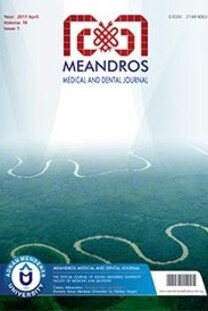A Comparison of Chewing Movements of Individuals with Normal Occlusion by the Patients with Orthodontic Abnormalities During Treatment Progress
Normal Oklüzyonlu Bireylerle Ortodontik Anomali Tedavisi Gören Hastaların Çiğneme Hareketlerinin Kıyaslanması
___
1. Thomas GP, Throckmorton GS, Ellis E, Sinn DP. The effects of orthodontic treatment on isometric bite forces and mandibular motion in patients before orthognathic surgery. J Oral Maxillofac Surg 1995; 53: 673-8.2. Hill L. An Introduction to Mastication Analysis in General Practice. Oral Heal Gorup 2016: 1-5.
3. Türker KS, Sowman PF, Tuncer M, Tucker KJ, Brinkworth RSA. The role of periodontal mechanoreceptors in mastication. Arch Oral Biol 2007; 52: 361-4.
4. Slavicek G. Human mastication. Int J Stomatol Occlusion Med 2010; 3: 29-41.
5. Fushima K, Gallo LM, Krebs M, Palla S. Analysis of the TMJ intraarticular space variation: A non-invasive insight during mastication. Med Eng Phys 2003; 25:181-90.
6. Kerstein RB, Radke J. Average chewing pattern improvements following Disclusion Time reduction Average chewing pattern improvements following Disclusion Time reduction. Cranio 2017; 35: 135-51.
7. Abreu M De, Domingues M, Furtado F, Pereira G, Prado R, Mestriner W, et al. ScienceDirect Masticatory efficiency and bite force in individuals with normal occlusion. Arch Oral Biol 2014; 59: 1065-74.
8. Schindler H, Eckehard S, Spiess WEL. Standardization of the registration and analysis of mastication: proposal for clinical application. J Prosthet Dent 2016; 9: 1-7.
9. Da Silva CG, Pachêco-Pereira C, Porporatti AL, Savi MG, Peres MA, Flores-Mir C, et al. Prevalence of clinical signs of intra-articular temporomandibular disorders in children and adolescents A systematic review and meta-analysis. J Am Dent Assoc 2016; 147: 10-18e8.
10. Kuwahara T, Bessette RW, Maruyama T. Chewing Pattern Analysis in TMD Patients with and without Internal Derangement: Part I. Cranio 1995; 13: 93-8.
11. Ishigaki S, Basette R, Maruyama T. Vibration of the temporomandibular joints with normal radiographic imagings: comparison between asymptomatic volunteers and symptomatic patients. Cranio J Craniomandib Pract 1993; 11: 88-94.
12. Kuwahara T, Miyauchi S, Maruyama T. Clinical classification of the patterns of mandibular movements during mastication in subjects with TMJ disorders. Int J Prosthodont 1993; 5: 122-9.
13. Fushima K, Gallo LM, Krebs M, Palla S. Analysis of the TMJ intraarticular space variation: A non-invasive insight during mastication. Med Eng Phys 2003; 25: 181-90.
14. Trawitzki LV V, Silva JB, Regalo SCH, Mello-Filho F V. Effect of class II and class III dentofacial deformities under orthodontic treatment on maximal isometric bite force. Arch Oral Biol 2011; 56: 972-6.
15. Ngom PI, Diagne F, Aïdara-Tamba AW, Sene A. Relationship between orthodontic anomalies and masticatory function in adults. Am J Orthod Dentofac Orthop 2007; 131: 216-22.
16. Yamashita S, Hatch JP, Rugh JD. Does chewing performance depend upon a specific masticatory pattern? J Oral Rehabil 1999; 26: 547-53.
17. Clark JR, Evans RD. Functional occlusion: I. A review. J Orthod 2001; 28: 76-81.
18. Kuwahara T, Besette R, Maruyama T. Characteristic Chewing Parameters for Specific Types of TMJ Internal Derangements, Kuwahara et al.pdf. Cranio - J Craniomandib Pract 1996; 14: 9086871.
19. Adnan Mazmanoglu. Herkes İçin Temel İstatistik Yöntemleri ve Uygulamaları (Basic Statical Methods and Applications for Everyone). Istanbul: Nobel Kitabevi; 2016.
20. McClave JT, Sincich T. Statistic. 2005th ed. Harvard: Prentice Hall; 2011.
21. Piancino MG, Bracco P, Vallelonga T, Merlo A, Farina D. Effect of bolus hardness on the chewing pattern and activation of masticatory muscles in subjects with normal dental occlusion. J Electromyogr Kinesiol 2008; 18: 931-7.
22. Winocur E, Davidov I, Gazit E, Brosh T, Vardimon AD. Centric Slide, Bite Force and Muscle Tenderness Changes Over 6 Months Following Fixed Orthodontic Treatment. Angle Orthod 2007; 77: 254-9.
23. Radke J. Chewing Pattern Differences Between Subjects Chewing with Different Rates 2015.
24. Lepley CR, Throckmorton GS, Parker S, Buschang PH. Masticatory performance and chewing cycle kinematics- Are they related? Angle Orthod 2010; 80: 295-301.
25. Owens S, Buschang PH, Throckmorton GS, Palmer L, English J. Masticatory performance and areas of occlusal contact and near contact in subjects with normal occlusion and malocclusion. Am J Orthod Dentofac Orthop 2002; 121: 602-9.
26. Yawaka Y, Hironaka S, Akiyama A, Matzuduka I, Takasaki C, Oguchi H. Changes in occlusal contact area and average bite pressure during treatment of anterior crossbite in primary dentition. J Clin Pediatr Dent 2004; 28: 75-9.
27. Okiyama S, Ikebe K, Nokubi T. Association between masticatory performance and maximal occlusal force in young men. J Oral Rehabil 2003; 30: 278-82.
- ISSN: 2149-9063
- Yayın Aralığı: 4
- Başlangıç: 2000
- Yayıncı: Aydın Adnan Menderes Üniversitesi
Seropositivity of Bartonella henselae in Risky Human Population, Cats and Dogs
Neriman AYDIN, Berna KORKMAZGİL, Şükrü KIRKAN, Murat TELLİ, Mete EYİGÖR, Atiye Meltem AKSOY, Uğur PARIN, Serten TEKBIYIK
Ali Onur ERDEM, Sezen ÖZKISACIK, Mesut YAZICI, Kamil Varlık EREL
Farklı Bulk Fill Kompozitlerin Su Emilimi, Çözünürlük ve Yüzey Pürüzlülüklerinin Değerlendirilmesi
Nihan GÖNÜLO, Emine ŞEN TUNÇ, Sezin ÖZER, Kemal YILDIZLI
Hastalarda Akılcı İlaç Kullanımı ve Sağlık Okuryazarlığı ile İlişkisi
Buket DEMİRCİ, Pınar OKYAY, Filiz ABACIGİL, Selen GÜRSOY TURAN, Filiz ADANA
Micro-shear Bond Strength of Aged Resin Composite Repaired with Different Universal Adhesives
Selexipag: Pulmoner Arteriyel Hipertansiyon için Yeni Bir Tedavi Ajanı
